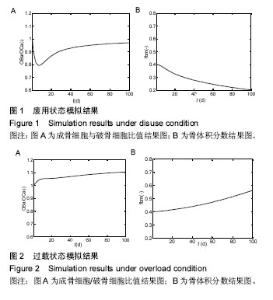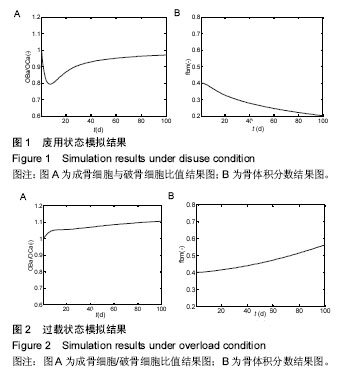Chinese Journal of Tissue Engineering Research ›› 2017, Vol. 21 ›› Issue (24): 3888-3893.doi: 10.3969/j.issn.2095-4344.2017.24.020
Previous Articles Next Articles
Mechanobiological model of bone remodeling based on mechano-growth factors
Ma Zong-min, Li Shu-xian
- Mechanical Engineering College of Dalian University, Dalian 116622, Liaoning Province, China
-
Revised:2017-04-25Online:2017-08-28Published:2017-08-30 -
Contact:Ma Zong-min, Mechanical Engineering College of Dalian University, Dalian 116622, Liaoning Province, China; Li Shu-xian, Lecturer, Mechanical Engineering College of Dalian University, Dalian 116622, Liaoning Province, China -
About author:Ma Zong-min, M.D., Lecturer, Mechanical Engineering College of Dalian University, Dalian 116622, Liaoning Province, China -
Supported by:the National Natural Science Foundation of China, No. 11572066 and 11602047
CLC Number:
Cite this article
Ma Zong-min, Li Shu-xian. Mechanobiological model of bone remodeling based on mechano-growth factors[J]. Chinese Journal of Tissue Engineering Research, 2017, 21(24): 3888-3893.
share this article

选取初始骨体积分数fbm为0.4,其他参数见表4,模拟时间为100 d,结果见图1和图2。图1为废用状态模拟结果,A为成骨细胞与破骨细胞比值OBa/OCa (初始比值进行了归一化处理),B骨体积分数变化图。从图1A可知:OBa/OCa初始下降剧烈,可能是由于载荷突然下降,骨组织迅速适应所致,然后逐渐收敛趋于稳定。由图1B可知,骨体积分数逐渐降低,大约100d趋于稳定。图2为过载状态模拟结果,A为成骨细胞与破骨细胞比值OBa/OCa (初始比值进行了归一化处理),B骨体积分数变化图。从图2A可知:OBa/OCa初始增加较快,可能是由于载荷突然增大,骨组织迅速适应所致,然后增加放缓趋于稳定。由图2B可知,骨体积分数逐渐增加。"

| [1] Frost HM.Bone“mass”and the“mechanostat”: a proposal.Anat Rec 1987;219:1-9.[2] Frost HM.Skeletal structural adaptations to mechanical usage (SATMU): 2.Redefining Wolff’s law: the remodelling problem. Anat Rec.1990;226:414-422.[3] Frost HM.Bone’s mechanostat: a 2003 update. Anat Rec.2003; 275A:1081-1101.[4] Tyrovola JB. The “mechanostat theory” of frost and the OPG/Rankl/RANK system. J Cell Biochem. 2015;116(12): 2724-2729.[5] Burger EH, Klein-Nulen J. Responses of bone cells to biomechanical forces in vitro. Adv Dent Res.1999;13:93-98.[6] 吴佳敏.宋关斌力生长因子对骨髓间充质干细胞迁移行为及相关生物力学特性的影响[J].重庆大学,2013.[7] Graham D M, Burridge K. Mechanotransduction and nuclear function. Curr Opin Cell Biol. 2016;40:98-105. [8] Chatterjee S, Fisher A B. Mechanotransduction: forces, sensors, and redox signaling. Antioxid Redox Signal. 2014;20(6): 868-871.[9] LaCroix A S, Rothenberg K E, Hoffman BD. Molecular-scale tools for studying mechanotransduction. Annu Rev Biomed Eng. 2015;17:287-316.[10] Spyropoulou A, Karamesinis K, Basdra EK. Mechanotransduction pathways in bone pathobiology. Biochim Biophys Acta. 2015;1852(9):1700-1708.[11] 林福春.力生长因子E肽(MGF-Ct24E)与应力作用对成骨细胞基因表达影响的基因芯片分析[D]. 重庆大学, 2011.[12] 佟雁翔, 冯卫, 贾燕飞,等. 力生长因子促进骨髓间充质干细胞向成骨细胞的分化[J]. 中国组织工程研究, 2016, 20(32):4717-4724.[13] Cui H, Yi Q, Feng J, et al. Mechano growth factor E peptide regulates migration and differentiation of bone marrow mesenchymal stem cells. J Mol Endocrinol. 2014;52(2):111-120.[14] Xin J, Wang Y, Wang Z, et al. Functional and transcriptomic analysis of the regulation of osteoblasts by mechano‐growth factor E peptide. Biotechnol Appl Biochem. 2014;61(2):193-201.[15] Li H, Lei M, Luo Z, et al. Mechano-growth factor enhances differentiation of bone marrow-derived mesenchymal stem cells. Biotechnology letters. 2015; 37(11): 2341.[16] Schlegel W, Raimann A, Halbauer D, et al. Insulin-like growth factor I (IGF-1) Ec/Mechano growth factor–a splice variant of IGF-1 within the growth plate. PloS one. 2013; 8(10): e76133.[17] Sheng MH, Lau KH, Baylink DJ. Role of osteocyte-derived insulin-like growth factor I in developmental growth, modeling, remodeling, and regeneration of the bone. J Bone Metab. 2014; 21(1):41-54. [18] Bakker A D, Jaspers RT. IL-6 and IGF-1 signaling within and between muscle and bone: how important is the mTOR pathway for bone metabolism?. Curr Osteoporos Rep. 2015;13(3): 131-139.[19] Juffer P, Bakker A D, Klein-Nulend J, et al. Mechanical loading by fluid shear stress of myotube glycocalyx stimulates growth factor expression and nitric oxide production. Cell Biochem Biophys. 2014;69(3):411-419.[20] Yanan Wang, Qing-Hua Qin. Parametric study of control mechanism of cortical bone remodeling under mechanical stimulus.Acta Mechanica Sinica.2010; 26(1):37-44.[21] Buenzli PR, Pivonka P,Gardiner BS,et al.Modelling the anabolic response of bone using a cell population model. J Theor Biol. 2012 ;307:42-52.[22] Scheiner S, Pivonka P, Hellmich C.Coupling systems biology with multiscale mechanics, for computer simulations of bone remodeling。Comput Methods Appl Mech Engrg.2013;254: 181-196.[23] Pivonka P, Buenzli PR, Scheiner S,et al. Dunstan。The influence of bone surface availability in bone remodeling-A mathematical model including coupled geometrical and biomechanical regulations of bone cells.Engineering Structures. 2013;47: 134-147.[24] Garijo N, Fernández J R, Pérez M A, et al. Numerical stability and convergence analysis of bone remodeling model. Computer Methods in Applied Mechanics and Engineering, 2014, 271: 253-268.[25] Graham J M, Ayati B P, Holstein S A, et al. The role of osteocytes in targeted bone remodeling: a mathematical model. PloS one. 2013; 8(5): e63884.[26] Liu Y Q, Han X F, Liu T, et al. A cell-based model of bone remodeling for identifying activity of icarrin in the treatment of osteoporosis. Biotechnology letters. 2015; 37(1): 219.[27] Emil N, Miron GH. Simulation of Bone Mechanical Adaptation using Different Mathematical Models: a Comparative Numerical Study. Key Engineering Materials. 2014; 638.[28] Pennline JA, Werner CR, Lewandowski B, et al. Development of Bone Remodeling Model for Spaceflight Bone Physiology Analysis. 2015.[29] Peng Q,Wang Y,Qiu J,et al.A novel mechanical loading model for studying the distributions of strain and mechano-growth factor expression. Arch Biochem Biophys. 2011;511(1-2):8-13.[30] 鲜成玉.机械拉伸对大鼠成骨细胞生理活性及IGF-1、力生长因子表达的影响[D].重庆大学,2005.[31] 张兵兵,鲜成玉,罗彦凤,等.拉伸刺激下MGF在成骨细胞中的表达及亚细胞定位分析[J].中国科学(C辑:生命科学),2009,39(5): 518-524.[32] Song Y, Yu C, Wang C, et al. Mechano growth factor-C24E, a potential promoting biochemical factor for ligament tissue engineering. Biochemical Engineering Journal. 2016;105: 249-263.[33] Song Y, Xu K, Yu C, et al. The use of mechano growth factor to prevent cartilage degeneration in knee osteoarthritis. J Tissue Eng Regen Med. 2017 Jun 9.[34] Luo Z, Jiang L, Xu Y, et al. Mechano growth factor (MGF) and transforming growth factor (TGF)-β3 functionalized silk scaffolds enhance articular hyaline cartilage regeneration in rabbit model. Biomaterials. 2015; 52: 463-475.[35] Mavrommatis E, Shioura K M, Los T, et al. The E-domain region of mechano-growth factor inhibits cellular apoptosis and preserves cardiac function during myocardial infarction. Mol Cell Biochem. 2013 ;381(1-2):69-83.[36] 辛娟.力生长因子E肽对体外骨形成与骨吸收的调控机制研究[D].重庆大学,2014.[37] Kobayashi Y, Hashimoto F, Miyamoto H, et al. Force-Induced Osteoclast Apoptosis In Vivo Is Accompanied by Elevation in Transforming Growth Factor β and Osteoprotegerin Expression. J Bone Miner Res. 2000;15(10):1924-1934.[38] Tang L, Lin Z, Li Y.Effects of different magnitudes of mechanical strain on osteobalsts in vitro. Biochem Biophys Res Commun. 2006;344(1):122-128.[39] Alon U.An Introduction to Systems Biology: Design Principles of Biological Circuits. CRC Press.2006.[40] Duchemin L, Bousson V, Raossanaly C, et al. Prediction of mechanical properties of cortical bone by quantitative computed tomography. Med Eng Phys. 2008 Apr;30(3):321-328.[41] 宋文静,戴钟铨,吴峰,等. 力生长因子与成骨细胞[J]. 首都师范大学学报:自然科学版,2013,34(1):41-46.[42] Dai Z,Wu F,Yeung EW,et al.IGF-IEc expression, regulation and biological function in different tissues. Growth Horm IGF Res. 2010;20(4):275-281.[43] Matheny RW Jr, Nindl BC, Adamo ML. Minireview: Mechano-growth factor: a putative product of IGF-I gene expression involved in tissue repair and regeneration. Endocrinology. 2010;151(3):865-875.[44] Yang S, Alnaqeeb M, Simpson H, et al. Cloning and characterization of an IGF-1 isoform expressed in skeletal muscle subjected to stretch. J Muscle Res Cell Motil. 1996; 17(4):487-495.[45] Neidlinger-Wilke C, Galbusera F, Pratsinis H, et al. Mechanical loading of the intervertebral disc: from the macroscopic to the cellular level. Eur Spine J. 2014 Jun;23 Suppl 3:S333-343.[46] Chen J C, Castillo A B, Jacobs C R. Cellular and Molecular Mechanotransduction in Bone//Osteoporosis: Fourth Edition. Elsevier Inc., 2013.[47] Lerebours C, Buenzli PR. Towards a cell-based mechanostat theory of bone: the need to account for osteocyte desensitisation and osteocyte replacement. Journal of biomechanics, 2016, 49(13): 2600-2606.[48] Buo AM, Stains JP. Gap junctional regulation of signal transduction in bone cells. FEBS letters. 2014;588(8): 1315-1321.[49] Zhou H. The essential role of Stat3 in bone homeostasis and mechanotransduction[M]. Purdue University, 2014.[50] Berkovich Y, Shapira J, Rosenberg N. Mechanotransduction in Osteoblats. Mesenchymal Cell Activation by Biomechanical Stimulation and its Clinical Prospects, 2016: 49.[51] Zhang Y, Chen S, Pei M. Biomechanical signals guiding stem cell cartilage engineering: from molecular adaption to tissue functionality. Eur Cell Mater. 2016, 31: 59-78. |
| [1] | Wang Jianping, Zhang Xiaohui, Yu Jinwei, Wei Shaoliang, Zhang Xinmin, Xu Xingxin, Qu Haijun. Application of knee joint motion analysis in machanism based on three-dimensional image registration and coordinate transformation [J]. Chinese Journal of Tissue Engineering Research, 2022, 26(在线): 1-5. |
| [2] | Zhang Yufang, Lü Meng, Mei Zhao. Construction and verification of a full spine biomechanical model of adolescent scoliosis [J]. Chinese Journal of Tissue Engineering Research, 2022, 26(9): 1351-1356. |
| [3] | Bai Zixing, Cao Xuhan, Sun Chengyi, Yang Yanjun, Chen Si, Wen Jianmin, Lin Xinxiao, Sun Weidong. Construction and biomechanical analysis of ankle joint finite element model in gait cycle [J]. Chinese Journal of Tissue Engineering Research, 2022, 26(9): 1362-1366. |
| [4] | Liu Feng, Feng Yi. Finite element analysis of different Kirschner wire tension bands on transverse patella fractures during gait cycle [J]. Chinese Journal of Tissue Engineering Research, 2022, 26(9): 1367-1371. |
| [5] | Yao Xiaoling, Peng Jiancheng, Xu Yuerong, Yang Zhidong, Zhang Shuncong. Variable-angle zero-notch anterior interbody fusion system in the treatment of cervical spondylotic myelopathy: 30-month follow-up [J]. Chinese Journal of Tissue Engineering Research, 2022, 26(9): 1377-1382. |
| [6] | Wang Jing, Xiong Shan, Cao Jin, Feng Linwei, Wang Xin. Role and mechanism of interleukin-3 in bone metabolism [J]. Chinese Journal of Tissue Engineering Research, 2022, 26(8): 1260-1265. |
| [7] | Xiao Hao, Liu Jing, Zhou Jun. Research progress of pulsed electromagnetic field in the treatment of postmenopausal osteoporosis [J]. Chinese Journal of Tissue Engineering Research, 2022, 26(8): 1266-1271. |
| [8] | An Weizheng, He Xiao, Ren Shuai, Liu Jianyu. Potential of muscle-derived stem cells in peripheral nerve regeneration [J]. Chinese Journal of Tissue Engineering Research, 2022, 26(7): 1130-1136. |
| [9] | Zhang Jinglin, Leng Min, Zhu Boheng, Wang Hong. Mechanism and application of stem cell-derived exosomes in promoting diabetic wound healing [J]. Chinese Journal of Tissue Engineering Research, 2022, 26(7): 1113-1118. |
| [10] | Duan Chao, Shang Xiaoqiang, Duan Xianglin, Yang Ping, Tao Shengxiang. Stability of patellar claw versus loop plate combined with patellar claw for the treatment of comminuted fractures of the lower pole of the patella [J]. Chinese Journal of Tissue Engineering Research, 2022, 26(6): 934-937. |
| [11] | Wen Mingtao, Liang Xuezhen, Li Jiacheng, Xu Bo, Li Gang. Mechanical stability of Sanders II type calcaneal fractures fixed by two internal fixation methods [J]. Chinese Journal of Tissue Engineering Research, 2022, 26(6): 838-842. |
| [12] | Huang Hao, Hong Song, Wa Qingde. Finite element analysis of the effect of femoral component rotation on patellofemoral joint contact pressure in total knee arthroplasty [J]. Chinese Journal of Tissue Engineering Research, 2022, 26(6): 848-852. |
| [13] | Zheng Yongze, Zheng Liqin, He Xingpeng, Chen Xinmin, Li Musheng, Li Pengfei, Lin Ziling. Extended finite element modeling analysis of femoral neck fracture based on ABAQUS software [J]. Chinese Journal of Tissue Engineering Research, 2022, 26(6): 853-857. |
| [14] | Liu Yuhang, Zhou Jianqiang, Xu Xuebin, Qu Xingyue, Li Ziyu, Li Kun, Wang Xing, Li Zhijun, Li Xiaohe, Zhang Shaojie. Establishment and validation of finite element model of lower cervical spine in 6-year-old children [J]. Chinese Journal of Tissue Engineering Research, 2022, 26(6): 870-874. |
| [15] | Chen Xiaoxu, Luo Yaxin, Bi Haoran, Yang Kun. Preparation and application of acellular scaffold in tissue engineering and regenerative medicine [J]. Chinese Journal of Tissue Engineering Research, 2022, 26(4): 591-596. |
| Viewed | ||||||
|
Full text |
|
|||||
|
Abstract |
|
|||||